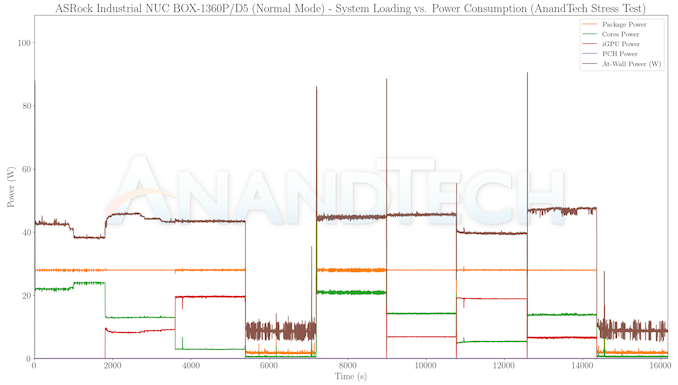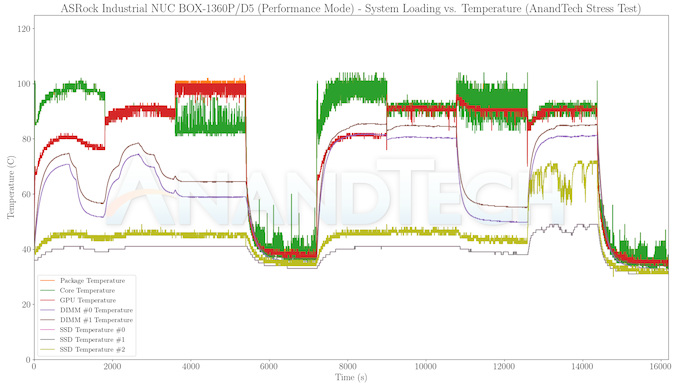ASRock Industrial NUC BOX-1360P/D5 Review: Raptor Lake-P on the Leading Edge
by Ganesh T S on July 18, 2023 10:30 AM EST- Posted in
- Systems
- Intel
- UCFF
- Mini-PC
- ASRock Industrial
- Raptor Lake-P
Power Consumption and Thermal Characteristics
The power consumption at the wall was measured with a 4K display being driven through the HDMI port of the system. In the graph below, we compare the idle and load power of the ASRock NUC BOX-1360P/D5 with other systems evaluated before. For load power consumption, we ran the AIDA64 System Stability Test with various stress components, as well as our custom stress test with Prime95 / Furmark, and noted the peak as well as idling power consumption at the wall.

The numbers are consistent with the TDP and suggested PL1 / PL2 values for the processors in the systems, and do not come as any surprise. We are glad that ASRock Industrial has finally addressed the idle power consumption numbers issue that had been plaguing their NUC BOX systems since Tiger Lake. At 5.19W idling, only the Arena Canyon and Wall Street Canyon NUCs have better numbers. The higher peak number for Arena Canyon NUC shows that it can possibly outperform the NUC BOX-1360P/D5 in performance mode for specific short-burst workloads.
Stress Testing
Our thermal stress routine is a combination of Prime95, Furmark, and Finalwire's AIDA64 System Stability Test. The following 9-step sequence is followed, starting with the system at idle:
- Start with the Prime95 stress test configured for maximum power consumption
- After 30 minutes, add Furmark GPU stress workload
- After 30 minutes, terminate the Prime95 workload
- After 30 minutes, terminate the Furmark workload and let the system idle
- After 30 minutes of idling, start the AIDA64 System Stress Test (SST) with CPU, caches, and RAM activated
- After 30 minutes, terminate the previous AIDA64 SST and start a new one with the GPU, CPU, caches, and RAM activated
- After 30 minutes, terminate the previous AIDA64 SST and start a new one with only the GPU activated
- After 30 minutes, terminate the previous AIDA64 SST and start a new one with the CPU, GPU, caches, RAM, and SSD activated
- After 30 minutes, terminate the AIDA64 SST and let the system idle for 30 minutes
Traditionally, this test used to record the clock frequencies - however, with the increasing number of cores in modern processors and fine-grained clock control, frequency information makes the graphs cluttered and doesn't contribute much to understanding the thermal performance of the system. The focus is now on the power consumption and temperature profiles to determine if throttling is in play.
The 'Normal Mode' graphs throw no surprise whatsoever. The package power remains constant at 28W during active loading, with the iGPU alone getting a 20W allotment at the maximum. On the temperature front, the CPU package and cores are kept below 85C even under extreme stress. The point of concern is the SSD temperature reaching 75C in the disk stress test segment. This is not particularly good for SSD reliability. ASRock Industrial must endeavour to provide some sort of thermal solution for the SSDs in their mini-PCs.
The power numbers in the 'Performance Mode' graph appear good - 40W sustained package power, with the iGPU getting around 32W. SSD temperatures go high in the disk stress segment, as expected. However, the more worrisome aspect is the core and package temperatures hitting 100C. This is bound to create thermal throttling in the system.














21 Comments
View All Comments
ganeshts - Wednesday, July 19, 2023 - link
Any links to such a 'NUC' ?I do have a Phoenix-based GTR7 from Beelink here in my testbed, but driver issues are preventing it from completing our benchmark suite. I am waiting for a new driver release from AMD.
lemurbutton - Friday, July 21, 2023 - link
And any M2 Mac Mini would destroy any Zen4 NUC.TheinsanegamerN - Monday, July 24, 2023 - link
Until you have to run something not in the MAC ecosystem. OOPS!PeachNCream - Friday, July 21, 2023 - link
I don't think destruction is quite the right to articulate your apparent thoughts. Perhaps "result in higher scores on benchmarks" or maybe "complete compute workloads sooner" would fit better in this case. Computer nerds appear to be rather detached from reality when expressing thoughts which gives all of them a bad reputation among the better positioned and more intelligent normal population.Samus - Saturday, July 22, 2023 - link
The problem with AMD enterprise and industrial products has always been management adoption. Intel has IT depts hooked on vPro, iME, AMT, etc.nicolaim - Wednesday, July 19, 2023 - link
It's 2023. Only two USB-C ports, none on the back.Samus - Thursday, July 20, 2023 - link
That was my gripe. Replace the HDMI and DP ports with two TB4-compliant USB-C ports on the rear would be the minimum modification for such an 'industrial' appliance. Seriously, why do you have to plug something into the front to use Thunderbolt?PeachNCream - Thursday, July 20, 2023 - link
Probably because nobody uses or cares about Thunderbolt. Sure it has that usual small, insane rabid fanbase that any obscure computer standard had in the past, but outside of the inevitable idiots that inflate its utility, no one cares and no one profits from it.abufrejoval - Monday, July 24, 2023 - link
That's a bit harsh.Yes, using TB to its full potential is somewhat expensive but given a choice, I'll always opt for the TB variant over pure USB, if only for 10Gbit Ethernet.
Front vs. back: I guess they have done their studies on how people use TB and unfortunately habits vary between people.
Most of my dual TB systems have one TB in the front, the other in the back and that works pretty well for me. The 10GBase-T NIC goes into the back port and the front port is open to anything transient, which could be just some USB media (these native SATA 10Gbit USB sticks are hard to beat via anything native TB), a temporary display (Alt-DP handy there) and in theory to things like TB networking, which is typically transient.
The older systems just have a single TB and expect a hub connected on the back, which seems sensible.
Two in the front and two in the back would be better still, even if you couldn't use all four at full speed for lack of PCIe lanes or a cheap enough switch.
Yet again, when your NUC is stuck to the back of a display, who cares what's front or back, because it's all behind the screen anyway and it's only people like me, wo use clusters of these NUCs as µ-servers in a "tiny-rack" who get bothered by the orientation of those ports.
Changing port orientation in a NUC means a mainboard redesign and few would want to pay for that. So I guess their asked their volume customers and this is what those came up with.
Very few vendors want to aggravate the customers.
sjkpublic@gmail.com - Thursday, July 20, 2023 - link
Performance comparison says it all. 1360P DOA. 7735U $100-200 cheaper for ASROCK. Even cheaper if you look at other companies.